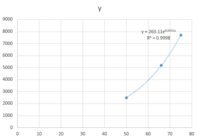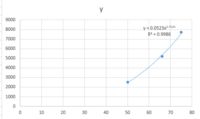Hey I'm sure this is actually quite simple, but I'm having trouble figuring out how to approach this.
I have 2 data sets of related numbers with diminishing returns, so I know it's exponential. I want to write an expression that illustrates the relationship between these two data sets, but I'm failing pretty miserably.
Data set 1 contains: 2500, 5200, 7700
Data set 2 contains: 50, 66, 75 (These are percentages)
I assumed since visually the curve would appear to have a limit of 100, I'd be dealing with a squared function (Incorrect thinking, but I digress). 50 happens to be a perfect square of 2500, so that checks out as x^2. But 66 is not the perfect square of 5200, so there's a coefficient I need to account for that invalidates this as being a function of the 2nd power.
So right now I'm looking aXb=Y Where X is data set 2 and Y is data set 1. How would I solve for a or b?
Edit: After a bit more consideration, I suppose the answer for b could be limited to odd numbers, because a negative X should cause Y to mirror over the X axis. I'd really like to be able to move away from graphic visualization when considering these things.
I have 2 data sets of related numbers with diminishing returns, so I know it's exponential. I want to write an expression that illustrates the relationship between these two data sets, but I'm failing pretty miserably.
Data set 1 contains: 2500, 5200, 7700
Data set 2 contains: 50, 66, 75 (These are percentages)
I assumed since visually the curve would appear to have a limit of 100, I'd be dealing with a squared function (Incorrect thinking, but I digress). 50 happens to be a perfect square of 2500, so that checks out as x^2. But 66 is not the perfect square of 5200, so there's a coefficient I need to account for that invalidates this as being a function of the 2nd power.
So right now I'm looking aXb=Y Where X is data set 2 and Y is data set 1. How would I solve for a or b?
Edit: After a bit more consideration, I suppose the answer for b could be limited to odd numbers, because a negative X should cause Y to mirror over the X axis. I'd really like to be able to move away from graphic visualization when considering these things.
Last edited:


